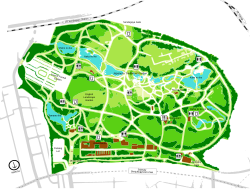Shinjuku Gyo-en(Tân túc ngự uyển,literally 'Shinjuku Imperial Garden')orShinjuku Gyoen National Gardenis a large public garden inShinjukuandShibuya,Tokyo, Japan. It was originally a residence of the Naitō family in theEdo period.It later became a garden under the management of JapanImperial Household Agency.It is now a national garden under the jurisdiction of theMinistry of the Environment.
| Shinjuku Gyo-en | |
|---|---|
| Shinjuku Gyoen National Garden | |
| Tân túc ngự uyển | |
 | |
 Map of the Shinjuku Gyo-en | |
| Type | National garden |
| Location | ShinjukuandShibuya,Tokyo,Japan |
| Coordinates | 35°41′06″N139°42′36″E/ 35.685°N 139.710°E |
| Area | 58.3 ha (144 acres) |
| Operated by | Ministry of the Environment, Japan |
| Open | May 1906 |
| Status | Open |
| Plants |
|
| Website | www.env.go.jp/garden/shinjukugyoen |
History
editTheshōgunTokugawa Ieyasubequeathed land in this area to a Naitōdaimyō(feudal lord) in 1590 for hisresidence in Edo.[1]The Naitō family completed a garden here in 1772.[2]In 1872, following theMeiji Restoration,the house and its grounds were converted into an experimental agricultural centre,[2]the Naito Shinjuku Experimental Station.[1]It became the Shinjuku Imperial Botanical Garden in 1879.[1]In 1901, head of the gardenHayato Fukubaasked landscape architectHenry Martinetof theÉcole nationale supérieure d'horticulturein Versailles to remodel the botanical garden into a landscape garden, and Shinjuku Imperial Garden (Shinjuku Gyoen), with its present layout, was opened in May 1906[2]with theEmperor Meijiin attendance.[1]
Most of the garden was burnt and greatly damaged by air raids in 1945, in the later stages of World War II, except for the Taiwan Pavilion.[1]After the war, jurisdiction over the garden, plus theTokyo Imperial PalaceOuter Garden and theKyoto Imperial Garden,was transferred to the Ministry of Health and Welfare (now theMinistry of Health, Labour and Welfare),[1]and the garden was rebuilt.[2]It reopened to the public on 21 May 1949 as Shinjuku Gyoen National Garden.[1]Jurisdiction was transferred to the Environment Agency when it formed in 1971, then to theMinistry of the Environmentwhen it succeeded the agency in 2001, where it remains.[1]
The 1989state funeral rites of emperor Hirohitowere held in the garden, before he was taken for burial at theMusashi Imperial Graveyard.
Features
editThis sectionneeds additional citations forverification.(May 2024) |
The garden, which is 58.3 hectares in area with a circumference of 3.5 km, blends three distinct styles: aFrench FormalandEnglish Landscapein the north and aJapanesetraditional garden in the south.[3]A traditional Japanese tea house is in the gardens. The garden is a favouritehanami(cherry-blossomviewing) spot, and large crowds can be present during cherry blossom season.
The garden has more than 20,000 trees, including approximately 1,500cherry trees,which bloom from late March (Shidareor Weeping Cherry) to early April (Someior Tokyo Cherry), and on to late April (KanzanCherry). Other trees include majestic Himalayan cedars, which soar above the rest of the trees in the garden, tulip trees, cypresses, and plane trees, which were first planted in Japan in the Imperial Gardens.
Horticulture work has been done in the garden greenhouses since 1892. Thepresent greenhouse,built in the 1950s, has over 1,700 tropical and subtropical plant species on permanent display.
Access
editThe garden has three access gates: Shinjuku Gate, Okido Gate, andSendagayaGate. Shinjuku Gyoen is open from 9:00 until 17:30 (mid-March until end of September; October–mid-March: until 16:00; July–late August: 18:30). On Mondays the garden is closed, except during the cherry blossom andchrysanthemumseasons: late March–late April, and first half of November respectively, when the garden is open seven days a week. If Monday is a public holiday, then closed the following day. During cherry blossom, prior reservations are required for several dates.[4]The greenhouse is open from 9:30 until 17:00 (mid-March until end of September; October–mid-March: until 15:30; July–late August: 18:00).
The garden is a short walk fromShinjuku-gyoemmae Stationon theMarunouchi Lineand fromSendagaya Stationon theChūō-Sōbu Line.It is on theTokyo Metro Fukutoshin LinenearShinjuku-sanchōme Station.It is a four-minute walk from exit C1 of that station.
In popular culture
editInYasunari Kawabata'sThe Sound of the Mountain,Shingo declares, "You can stretch out. It's like getting out of Japan - I wouldn't have dreamed that there was a place like this right in the middle of Tokyo."[5]
It is the setting of the 2013animefilmThe Garden of Words.[6]
Gallery
edit-
Shinjuku Gyo-en
-
Cherry blossom in Shinjuku Gyo-en
-
Chrysanthemum flower exhibition, 2010
-
A few scenes inside the garden in early spring 2023
-
Wooden footbridge in Shinjuku Gyo-en
-
Shinjuku Gyo-en in fall
References
edit- ^abcdefgh"Shinjuku Gyoen National Garden: History".Ministry of the Environment, Japan.Retrieved2 May2024.
- ^abcdMansfield, p. 15.
- ^"Shinjuku Gyoen National Garden: Outline".Ministry of the Environment, Japan.Retrieved2 May2024.
- ^Official Website: Visiting information
- ^Kawabata, Yasunari (1970).The Sound of the Mountain.New York: Vintage International. pp. 187–193.ISBN9780679762645.
- ^Johnny (14 March 2016)."Tokyo as Seen Through the Animated Film The Garden of Words".Spoon & Tamago.Archived fromthe originalon 27 September 2021.Retrieved1 February2017.
Bibliography
edit- Mansfield, Stephen (2011).Japan's Master Gardens - Lessons in Space and Environment(Hardback). Tokyo, Rutland, Singapore: Tuttle.ISBN978-4-8053-1128-8.